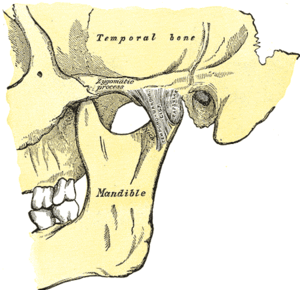Temporomandibular ligament
| Ligament: Temporomandibular ligament | ||
|---|---|---|
 | ||
| Articulation of the mandible. Lateral aspect. | ||
| Latin | ligamentum laterale articulationis temporomandibularis, ligamentum temporomandibulare | |
| Gray's | p.297 | |
| From | zygomatic process of temporal bone | |
| To | condyloid process (mandible) | |
| Dorlands/Elsevier | l_09/12492499 | |
The temporomandibular ligament (external lateral ligament) consists of two short, narrow fasciculi, one in front of the other, attached, above, to the lateral surface of the zygomatic arch and to the tubercle on its lower border; below, to the lateral surface and posterior border of the neck of the mandible.
It is broader above than below, and its fibers are directed obliquely downward and backward.
It is covered by the parotid gland, and by the integument.
It prevents posterior displacement of the mandible and prevents the condyloid process from being driven upward by a blow and fracturing the base of the skull.
This article incorporates text from a public domain edition of Gray's Anatomy.
References
Saladin, Kenneth S. (2005) Human Anatomy. New York, NY: McGraw-Hill. ISBN 0-07-039080-0
| |||||||||||||||||